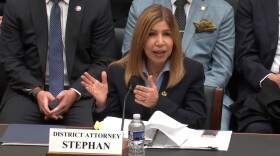Football concussions no longer are the elephant in the room.
Another season is in full swing, and talk about concussions is everywhere -- from the National Football League to college to high school on down.
Congress is interested: A House Committee had a hearing Thursday to deal with how best to safeguard young athletes.
And then there's this from researchers: A college player who recently committed suicide had a degenerative brain disease normally linked to much older players. It's prompting a new round of questions about safety in the dangerous game that Americans love.
The Most Popular Player
Before the University of Pennsylvania's opening game in Philadelphia on Sept. 18, the public address announcer at Franklin Field urged those gathered to remember one of their own.
"At this time, we ask that you join the Penn football players, coaches and staff as we honor Owen Thomas with a moment of silence," he said.
Thomas, No. 40 for the University of Pennsylvania, was supposed to be on the field for the coin toss before the home opener that Saturday night. The all-Ivy League defensive lineman with the bright-red hair was a co-captain (the most popular kid on the team, the coach said). No. 40 was there at Franklin Field, but it was in the form of a decal on the Penn players' helmets, and a 40-second-long silent tribute.
On April 26, 21-year-old Thomas killed himself -- suddenly, impulsively, his family said. According to reports, Thomas didn't leave a note. He was found with his cell phone still in his pocket. His parents agreed to let researchers at Boston University study Thomas' brain.
"His brain showed what I would call early onset chronic traumatic encephalopathy," Dr. Robert Cantu, one of the directors at the BU research center, said afterward.
Disease Of The Moment
CTE is the football concussion "disease of the moment." In the past couple of years, Boston University's Center for the Study of Traumatic Encephalopathy has revealed that many deceased NFL players had CTE. The symptoms include depression, erratic behavior and, ultimately, dementia. Some of the former players committed suicide or exhibited suicidal behavior. Researchers at BU say it's impossible to definitively link Thomas' suicide to CTE. But another aspect of his case was startling.
Many of the other CTE victims had a history of repeated, documented football-related concussions. Thomas, who started playing football as a 9-year-old, did not.
"Thousands of subconcussive blows can probably be just as deleterious as a blow at the concussion level," Cantu said.
Translation: The mere act of playing football with its many, seemingly innocuous collisions, could be silently wreaking havoc on the brain.
The Hit Count
Because of the potential for harm from the many lesser impacts to the head, Cantu says it's necessary to take a page from another game -- baseball.
"We have pitch counts for pitchers from Little League to the majors, who want to limit the number of pitches they throw and protect their arms," he said. "We're probably going to have to go to hit counts to the head in our football players to protect the brain."
Monitoring the number of blows to the head has been a full-time project for Dr. Gunnar Brolinson, the head doctor for the Virginia Tech football team, since 2003. The Hokies were the first college team to put in place hit-count technology.
Games and practices have doubled as a brain laboratory for Brolinson. The technology he uses consists of small sensors placed inside players' helmets. A device on the sideline, the size of a small footlocker, receives data from the sensors and then displays information on a laptop computer screen.
Brolinson monitors the screen, which depicts a computer-generated head, and colored arrows on different parts of the head that show the location and magnitude of a head hit.
"I'm looking at a head blow right now on one of our players," he said, demonstrating the system. "And I can see that he's had a blow that's on the left, lateral side of the head. The length of the arrow [on the head] corresponds to a blow that is about a 58 G head acceleration."
Fifty-eight Gs, he says, is a relatively typical football-related acceleration, or impact. To confirm that, Brolinson looks up from the computer screen and finds the player on the field.
"The player looks fine," he says, adding, "he's out there running around."
Still Early Research
The HIT system, as it's called, is expensive. Brolinson says the cost is about $60,000 for a college football team. An individual helmet is $1,000. The price is one of the reasons the system's use is limited at this point to a handful of colleges, universities and high schools.
Creators of the HIT system say they are developing a version that will be more affordable and, they hope, more widely used.
Those who use it now have established average hit counts for different players. Linemen, like Thomas, collide on every play, so they have the highest hit counts. The statistics show they log anywhere from 1,000 to 1,500 head hits per season. But Brolinson cautions against drawing conclusions from the numbers alone. The research, he says, still is very young.
"We have no idea if that thousand hits is a bad number," he says. "That's the importance of doing this research and carrying it forward."
We have no idea if that thousand hits is a bad number. That's the importance of doing this research and carrying it forward.
Brolinson says he hopes in three to five years, if his project continues, he will have a better idea of what numbers constitute a danger zone for football players.
He also says the Thomas story shouldn't cause a knee-jerk reaction among those worried that CTE signals a widespread problem in football. CTE research is evolving as well, Brolinson says. Not every football player with a lot of head hits gets the disease. Brolinson and others think CTE may have a genetic component to it.
Change The Game?
Still, Thomas' case has ratcheted up the discussion about how to reduce the number of football head impacts -- big and small.
In Chapel Hill, N.C., longtime football concussion researcher Dr. Kevin Guskiewicz talks to his 10- and 14-year-old sons, who both play football.
"I ask them everyday over dinner what they went over today, what they learned today," he says. "I force them to come up with one or two new things they learned, in terms of how to protect themselves.
"I would hope that other parents would be doing the same, and I hope the coaches would be responsible enough to provide an answer for those kids when parents ask what they learned."
Most coaches teach tackling and blocking with the head up. "See what you hit" is the mantra. But the message doesn't always get through.
I cannot watch a football game without seeing a guy lead with his head on almost every play. That can't be allowed.
Guskiewicz ran a six-year study that showed one in five college football head impacts happened at the top of the head. That's alarming to Guskiewicz and to Dave Halstead, who is intimately involved in the industry dedicated to protecting football players.
"I cannot watch a football game," he says, "without seeing a guy lead with his head on almost every play. That can't be allowed."
Halstead does laboratory testing on football helmets; he consults with the NFL and the NFL Players Union on helmet performance. Safer headgear isn't the issue for him. The best defense against brain injury, he says, is teaching the game the right way. To make sure all coaches do that and take it seriously, Halstead suggests a rule against any intentional headfirst contact.
Then, of course, officials would have to call the penalties when they see them. Getting to that point will be a challenge "because every play, there'd be 27 flags," Halstead says, only half-kidding. "They're all 15-yard penalties. The field's not big enough."
Amid the outcry about the risk of brain trauma in football, it's important to note that there was a time when players died from injuries that now result in concussions. Knowledge, equipment and rules all have changed to better protect the players. Now, there's momentum for a next round of change.
For some, it can't come soon enough.
Copyright 2022 NPR. To see more, visit https://www.npr.org. 9(MDAzMjM2NDYzMDEyMzc1Njk5NjAxNzY3OQ001))






